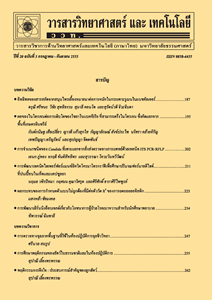การทดสอบกำลังอัดจากเถ้าหนักของปาล์มน้ำมันเพื่อมาเป็นวัสดุถมกลับในงานปิโตรเลียม
Main Article Content
บทคัดย่อ
งานวิจัยนี้มีวัตถุประสงค์เพื่อศึกษาสมบัติพื้นฐานของเถ้าหนักปาล์มน้ำมันที่สามารถนำไปใช้ประโยชน์ในการเป็นวัสดุถมกลับ โดยใช้เทคนิคเอกซเรย์ฟลูออเรสเซนต์สำหรับการวิเคราะห์ธาตุ ค่ากำลังแรงอัด และค่าความหนาแน่นของมอร์ตาร์ที่ผสมเถ้าหนักจากปาล์มน้ำมัน การทดลองนี้ใช้เถ้าหนักจากปาล์มน้ำมันโดยมีการแทนที่ของซีเมนต์ในปริมาณร้อยละ 5, 10 และ 15 โดยน้ำหนัก ซึ่งควบคุมให้เถ้าหนักมีการกระจายตัวของอนุภาค โดยแบ่งสภาพเป็นไม่บ่มน้ำ บ่มน้ำ 7 วัน และบ่มน้ำ 28 วัน ผลการวิเคราะห์และทดลองพบว่าเถ้าหนักจากปาล์มน้ำมันมีแคลเซียมออกไซด์ 26.71 เปอร์เซ็นต์ ทำให้มีสมบัติเป็นวัสดุปอซโซลาน และค่ากำลังแรงอัดเพิ่มขึ้นเมื่อผสมซีเมนต์ที่มากขึ้น โดยมอร์ตาร์ซีเมนต์แทนที่เถ้าหนักจากปาล์มน้ำมันร้อยละ 15 โดยน้ำหนัก บ่มน้ำ 28 วัน มีค่ากำลังอัด 2.10 เมกะปาสคาล นอกจากนี้การใช้ซีเมนต์แทนที่เถ้าหนักจากปาล์มน้ำมันในปริมาณที่เพิ่มขึ้นจะส่งผลให้ค่าความหนาแน่นของมอร์ตาร์เพิ่มขึ้น โดยมอร์ตาร์ที่ผสมซีเมนต์แทนที่เถ้าหนักจากปาล์มน้ำมันร้อยละ 15 มีค่าความหนาแน่น 5,605.10 กิโลกรัมต่อลูกบาศก์เมตร การพัฒนากำลังแรงอัดของมอร์ตาร์ที่บ่มน้ำ 28 วัน จะเพิ่มขึ้นเมื่อร้อยละการแทนที่ของเถ้าปาล์มน้ำมันด้วยซีเมนต์เพิ่มขึ้น กำลังแรงอัดของมอร์ตาร์เพิ่มขึ้นเมื่อระยะเวลาการบ่มน้ำเพิ่ม
Article Details
เอกสารอ้างอิง
Niroj, N., 2014, Study on properties of leterite soil portland cement and slag mix as a pavement materials, Thai Sci. Technol. J. 4(1): 25-31. (in Thai)
Lohsomboon, P., Jirajariyavech, A., Silalert ruksa, W. and Preedaphatarapong, W., 2005, Database Preparation of Cycle Assessment in Cement and Steel Production for Environmental Management, The Thailand Research Fund (TRF), Bangkok.
Prachom, K., 2005, Properties of quarry dust for use as fine aggregate, Appl. Mech. Mater. 16(2): 1-5. (in Thai)
Mostafa, B., Fall, M. and Belem, T., 2004, A contribution to understanding the hardening process of cemented pastefill, Miner. Eng. 17: 141-152.
Mostafa, B., Fiset, J.F., Bussiere, B., Villeneuve, M. and Plante, B., 2006, Sludge recycling within cemented paste backfill: Study of the mechanical and leachability properties, Miner. Eng. 19: 420-432.
Piyang, T., Sagulsawasdipan, K. and Sawain, A., 2018, A study of palm oil fuel ash in manufacturing in production footpaths concrete stabs, Wichcha J. 37(1): 81-94. (in Thai)
Wongkeo, W., Thongsanitgarn, P., Pimraksa, K. and Chaipanich, A., 2012, Compressive strength, flexural strength and thermal conductivity of autoclaved concrete block made using bottom ash as cement replacement materials, Mater Design 35: 434-439.
Sinsiri, T., Kroehong, W., Jaturapitakkul, C. and Chindaprasirt, P., 2012, Assessing the effect of biomass ashes with different finenesses on the compressive strength of blended cement paste, Mater Design 42: 424-433.
Surin, M. and Teerawut, M., 2007, Influences of Palm Oil Fuel Ash from Upper Southern Part of Thailand on Properties of Mortar Portland Cement, Master Thesis, King Mongkut’s University of Technology Thonburi, Bangkok, 284 p.
Wanchok, K. and Apiwit, P., 2017, Mechanical properties, microstructure, thermal conductivity and drying shrinkage of cellular lightweight concrete containing bagasse ash, J. Ind. Tech. 13(2): 22-38. (in Thai)
Metwally, A., 2014, Compressive strength prediction of Portland cement concrete with age using a new model, HBRC 10: 145-155.
Malhotra, V.M. and Mehta, P.K., 1996, Pozzolanic and Cementitious Materials, Gordon and Breach Science Publishers, Amsterdam, 189 p.
Hewlett, P., 1998, Lea’s Chemistry of Cement and Concrete, 4th Ed., Edward Arnold, Ltd., New York City, NY., 845 p.
Naganathan, S., Razak, H. and Hamid S.N.A., 2012, Properties of controlled low-strength material made using industrial waste incineration bottom ash and quarry dust, Mater. Des. Eng. 33: 56-63.
Wu, W., Zhang, W. and Ma, G., 2010, Optimum content of copper slag as a fine aggregate in high strength concrete, Mater. Des. Eng. 31: 2878-2883.
Chindaprasirt, P., Jaturapitakkul, C. and Sinsiri, T., 2007, Effect of fly ash fineness on microstructure of blended cemented paste, Constr. Build Mater. 21: 1534-1541.
Samrej, S., 2013, Usage of Fly Ash for Manufacturing Interlocking Block, Master Thesis, Suranaree University of Techno logy, Nakhon Ratchasima, 52 p.
Runglawan, R. and Suksun, H., 2003, Consolidation and permeability characte ristics of cemented clays, Appl. Mech. Mater. 14(3): 25-31. (in Thai)


